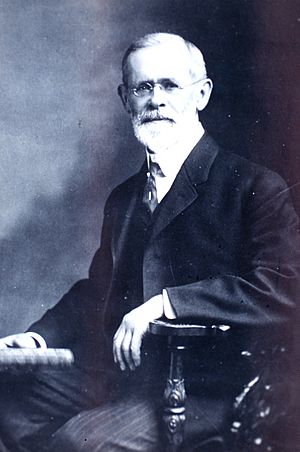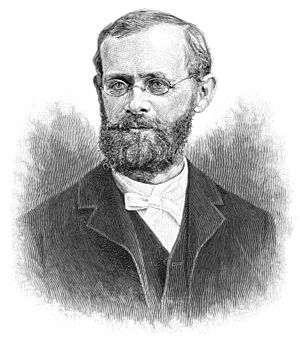Cleveland Abbe facts for kids
Quick facts for kids
Cleveland Abbe
|
|
|---|---|
 |
|
| Born | December 3, 1838 New York City, U.S.
|
| Died | October 28, 1916 (aged 77) Chevy Chase, Maryland, U.S.
|
| Resting place | Rock Creek Cemetery Washington, D.C., U.S. |
| Nationality | American |
| Education | |
| Occupation | Meteorology |
| Organization | National Weather Service National Geographic Society City College of New York |
| Spouse(s) |
Frances Martha Neal (1870-1908)
|
| Children | Cleveland Abbe Jr. Truman Abbe |
| Awards | Symons Gold Medal (1912) Public Welfare Medal (1916) |
| Signature | |
Cleveland Abbe (born December 3, 1838 – died October 28, 1916) was an American scientist. He is famous for his work as a meteorologist, which means he studied the weather. He also played a big part in creating the time zones we use today.
While working at the Cincinnati Observatory in Cincinnati, Ohio, he came up with a smart way to share weather information. He used telegraphs to send daily weather reports and create weather maps. He also started making daily weather forecasts. Because of his great work, the U.S. Weather Bureau was started in 1870. They began using daily weather forecasts, and Cleveland Abbe became the first head of this new service. People often called him "Old Probability" because his forecasts were so reliable!
Contents
Cleveland Abbe's Early Life
Cleveland Abbe was born in New York City. He grew up in a wealthy family. From a young age, he was very good at math and chemistry. He earned his first degree from the Free Academy in 1857.
After college, he taught math and engineering for a few years. He also studied astronomy, which is the study of stars and planets. When the Civil War began, he tried to join the army but couldn't because of his eyesight. So, he spent the war years studying at Harvard. There, he worked with a famous astronomer named Benjamin Gould.
After Harvard, he traveled to Russia to study astronomy even more. He loved his time there, surrounded by other smart scientists. In 1868, he became the director of the Cincinnati Observatory. While there, he noticed how much weather affected astronomers' work. This made him very interested in meteorology. He believed that weather forecasts could be made easily and even help people.
His Amazing Weather Career
Cleveland Abbe's first big weather project was forecasting and warning people about bad storms. He started this work in Cincinnati. His very first weather bulletin came out on September 1, 1869.
On January 3, 1871, Abbe was chosen to be the chief meteorologist for the United States Weather Bureau. At first, it was part of the Signal Corps, which was a military group. Abbe quickly realized that predicting weather needed a large, organized team.
He got some money from the Cincinnati Chamber of Commerce. With this, he found twenty people who volunteered to observe the weather. Western Union, a telegraph company, agreed to let them send their reports for free! Abbe chose the best tools for collecting weather data. He also trained Army sergeants to use them.
Weather information was sent using a special code to save words. At certain times, all the information would flood into the main stations. Clerks would then decode the messages. They would write the data onto weather maps by hand. These maps were then used to predict the weather.
On February 19, 1871, Cleveland Abbe gave the first official weather report himself. He continued to make forecasts alone for six months. During this time, he also trained others. Soon, two Army lieutenants and another professor joined him. This helped share the heavy workload.
Abbe insisted that forecasts be very clear. Every forecast had to cover four main things:
- The weather (like clouds and rain)
- The temperature
- The wind direction
- The barometric pressure (how heavy the air is)
By the end of the first year, over 60 copies of weather charts were sent to important groups like Congress and newspapers. By 1872, Abbe was sending over 500 sets of daily maps and bulletins to other countries. In return, he received their weather data. Abbe also made sure to check if his predictions were correct. In 1871, 69% of his predictions were right!
Starting the Monthly Weather Review
Abbe also started a science magazine called the Monthly Weather Review in 1872. He was the first editor. He continued to edit it from 1892 until just before he passed away in 1915. This magazine shared important weather information and discoveries.
Creating Time Zones
To collect weather information properly, Abbe needed a way for all stations to use the same time. This led him to divide the United States into four standard time zones. In 1879, he wrote a paper about this idea.
In 1883, he convinced railroad companies in North America to use his time zone system. This was a huge step! In 1884, other countries, like Britain, helped get international agreement for a worldwide time system. Eventually, the American government also adopted his time zone system.
New Weather Tools
Abbe wanted the weather service to always use the newest technology. His team tested and fixed thousands of weather tools. They even started designing and building their own! By the late 1800s, automatic recording equipment was used. The U.S. led the world with 114 stations that recorded weather automatically.
Abbe also wanted to use tools that met international standards. He asked scientists from Harvard and Yale to design better equipment. He even ordered special barometers and anemometers (wind speed tools) from other countries to compare them. He even invented his own tool, an anemobarometer, to test how chimneys affected barometers.
Teaching and Awards
In 1886, Abbe started teaching meteorology at Columbian University. He taught there until 1905. He also lectured at Johns Hopkins University from 1896 to 1914. He wrote almost 300 scientific papers!
He received many honors and awards for his work. In 1912, the Royal Meteorological Society gave him the Symons Gold Medal. They praised his work in all areas of meteorology and forecasting. In 1916, he received the Public Welfare Medal from the National Academy of Sciences. He was also one of the 33 people who started the National Geographic Society.
Cleveland Abbe passed away in 1916, after more than 45 years of amazing scientific achievements. He was buried in Rock Creek Cemetery in Washington, D.C. In his free time, he enjoyed learning about different cultures, ancient history, rocks, plants, and music.
Timeline
- December 2, 1838
- Born in New York, NY
- 1857
- Earned B.A. from College of the City of New York
- 1859-1860
- Taught engineering at the University of Michigan
- 1860
- Earned M.A. from College of the City of New York
- 1861-1864
- Assisted Benjamin Apthorp Gould with longitude measurements
- 1864-1866
- Guest astronomer at Observatory of Pulkovo, Russia
- 1867-1868
- Worked at the United States Naval Observatory
- 1868-1873
- Director of Cincinnati Observatory
- 1869
- Began publishing daily weather reports in Cincinnati
- May 10, 1870
- Married Frances Martha Neal
- 1871-1916
- Meteorologist for the U.S. Signal Corps and Weather Bureau
- 1884-1916
- Professor of meteorology at Columbian (George Washington) University
- 1895-1916
- Lecturer on meteorology at Johns Hopkins University
- 1906
- Awarded the Franklin Medal
- April 12, 1909
- Married Margaret Augusta Percival
- 1912
- Awarded the Symons Gold Medal
- 1916
- Awarded the Marcellus Hartley Medal
- October 28, 1916
- Died in Chevy Chase, MD
Images for kids
See also
 In Spanish: Cleveland Abbe para niños
In Spanish: Cleveland Abbe para niños



